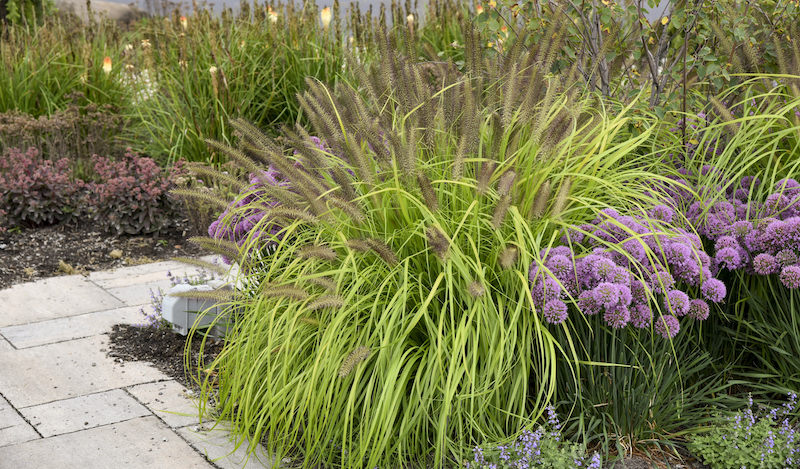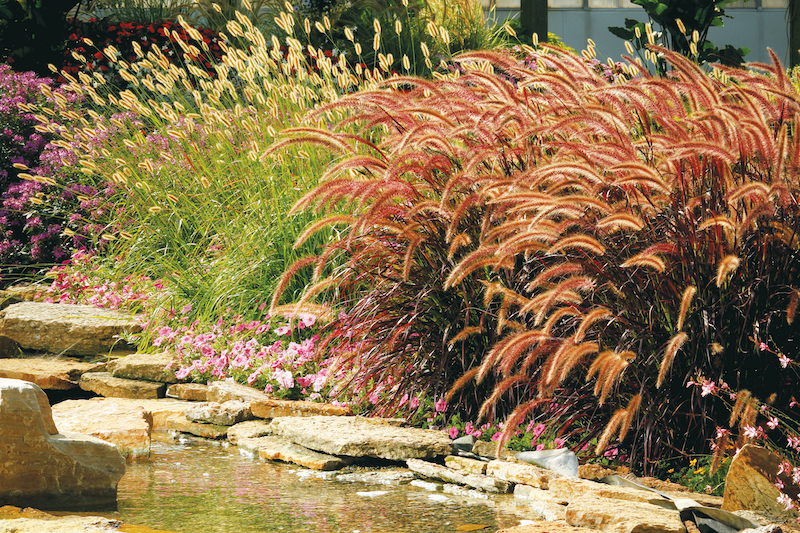Growing Fountain Grass
Fountain grass, also known as the Pennisetum genus, is an ornamental grass with an arching, vase-like shape, and feathery flower plumes. These grasses come in annual and perennial varieties, in a range of colors, from purple, green, and bronze to variegated forms. Fountain grasses vary in size from 1 – 5 feet high and 1 – 4 feet wide.
Fountain grasses are warm-season grasses, which means that they do most of their growing during the warmer summer months. They are well suited to hot, sunny, humid areas. They also make excellent container plants.

Planting Fountain Grass
Fountain grasses perform best in full sun, with at least 6 – 8 hours of direct sunlight per day. They adapt to various soil conditions, including sand, clay, alkaline, and acidic soils. They grow best in fertile, well-drained soil.
Find a sunny location and dig a hole just wide enough for the root ball. Set the crowns slightly above the soil surface to prevent crown rot. Backfill the hole with soil and water thoroughly to saturate the soil. Add a layer of organic compost around the root zone to conserve moisture.

Watering Fountain Grass
Fountain grass is considered drought tolerant. Once established, it will only need occasional supplemental water in the summer. During the first two growing seasons, water this grass regularly to establish a strong root system. Even established plants should be watered weekly during hot, dry spells to keep these grasses looking fresh.
Grasses grown in pots dry out more frequently than those in the ground and should be watered when the soil feels dry to the touch. This is usually once or twice a week in the summer.
Fertilizing Fountain Grass
This ornamental grass does not need to be fertilized. Topdressing the root zone with organic compost each spring should be sufficient for conditioning most garden soils. However, if a soil test shows that your soil is deficient in nitrogen and potassium, you can apply a general-purpose fertilizer in the spring at half strength to give this grass a boost. Try a water-soluble formula with a 10-10-10 balanced N-P-K ratio. Be careful not to overdo it because excess fertilizer can promote too much foliage at the expense of flowers.
Pruning Plant Fountain Grass
Fountain grass will die back over the winter and can be cleaned up in the spring before new growth starts. Use a pair of sharp, sterilized pruning shears to cut the stems to about 4 inches above the ground. Some gardeners may be tempted to cut this grass back in the fall, but leaving the spent foliage during the winter helps protect the crown from freezing, wet conditions, and provides habitat for burrowing insects and birds.

Caring For Fountain Grass in Pots
Fountain grass is easy to grow in containers. Choose a frost-proof container with large drainage holes. The container should be big enough to accommodate the root ball and allow room for growth.
Use an all-purpose potting soil that is for formulated for container plants. Pot the grass only as deep as it was originally planted, and leave a couple inches at the top of the container for watering. Water regularly during the growing season and apply a well-balanced fertilizer at half strength in the spring.

Winter Care for Fountain Grass
Most fountain grass varieties need little to no care during the winter, depending on their hardiness rating. Pennisetum alopecuroides, or Chinese fountain grass, comes in several different cultivars that are typically hardy from zone 5 to 10. This grass does not need any special winter protection when grown in its hardiness range. In zone 4, apply a thick layer of mulch around the base to protect the crown from severe cold during the winter. In the spring, cut this grass back to a few inches above the ground.
The magnificent purple fountain grass, or Pennisetum setaceum 'Rubrum', is only hardy in zones 9-10 and should be treated as an annual in colder zones. Store this plant in a frost-free space to overwinter.
Common Care Questions About Fountain Grass
Is Fountain Grass An Annual Or Perennial?
Fountain grass is a perennial. It can be grown as an annual for summer and fall colors in colder climates.
Should Fountain Grass Be Cut Back?
Trim fountain grass in the late winter or early spring. Avoid pruning in the fall before the plant has had time to go dormant.
What Happens If You Don't Cut Fountain Grass Back?
Generally, ornamental grass may look messy when not cleaned up and also might spread its seeds around the area. New growth in the spring may be difficult to grow through the old foliage
Is Fountain Grass Deer Resistant?
It is one of the few types of grass that are resistant to deer browsing. The reason for this is that fountain grass has sharp leaf edges and flower spikes.
Is Fountain Grass Invasive?
It is invasive and will pop up wherever there is soil.
When Do You Plant Fountain Grass?
Generally, ornamental grasses, are best planted around fall or spring. However, it's recommended to plant it in spring to take advantage of the peak growing season
Can Fountain Grass Grow In Shade?
Fountain grass can tolerate shade however, will not bloom well.
How Do I Divide Fountain Grass?
https://plantaddicts.com/dividing-ornamental-grasses/
Is Fountain Grass Poisonous?
Fountain grasses are considered nontoxic to pets and humans.
Is Fountain Grass Edible?
Fountain grass is considered nontoxic to humans and animals, making it edible however not recommended for consumption.
Fountain Grass Isn't Blooming
Fountain grass does not flower well when in shade.
What Is The Growth Rate Of Fountain Grass?
It has a fast growth rate and is best planted in spring.
Is Fountain Grass Drought Tolerant?
They are quite drought tolerant once established.
Why Is Fountain Grass Turning Yellow, Brown, and/or Black?
The most common reasons include watering issues, soil pH issues, over or under exposure of sunlight, temperature fluctuation, excessive fertilization, bacteria, disease, and natural pests.
Can Fountain Grass Grow Indoors?
Yes, Fountain grass, like any other can be grown indoors. Keep it moist, not wet and soggy.
Have a question about Fountain Grass? Fill out the form below and we will try and get back to your question as soon as possible. We may even feature your question in this article to help other gardeners!
 |
Author Jessica Mercer - Published 7-13-2022 |
